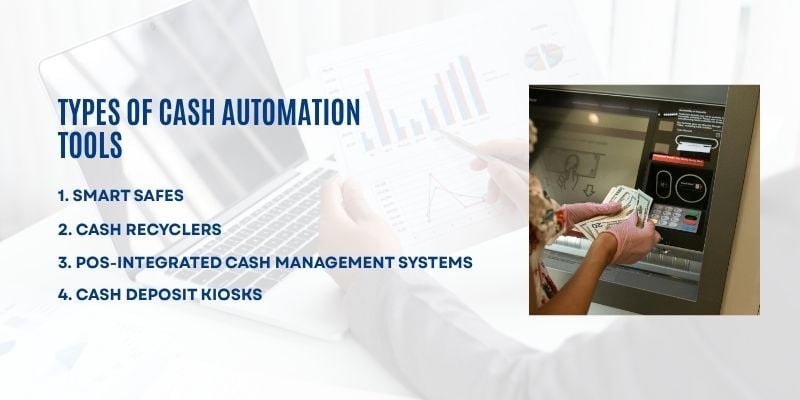Managing physical cash remains a daily challenge for businesses that process high transaction volumes, especially in the retail, quick-service restaurant, banking, and hospitality sectors.
Cash handling is time-consuming, often prone to error, and exposes businesses to risk, whether it’s internal theft, miscounts, or delays in reconciliation. Staff spend valuable hours on tasks that don’t directly serve customers.
Cash management automation provides a practical solution. Instead of relying on manual drawer counts, overnight deposits, or fragmented reporting, businesses can adopt secure, automated systems that simplify the process of accepting, storing, and tracking cash.
These solutions reduce dependency on human input, reduce reconciliation time, and enhance visibility across locations.
In this article, we’ll examine the benefits of cash management automation, from improving accuracy and reducing losses to freeing up staff for higher-value work.
For organizations seeking to minimize operational friction, automation is no longer optional; it is becoming the standard.
What is Cash Management Automation?
Cash management automation means replacing time-consuming manual cash tasks with machines and software that handle them faster, more securely, and with greater accuracy.
Businesses often rely on devices such as smart safes, cash deposit kiosks, and cash recyclers to automatically count, sort, validate, and store money.
These systems reduce the need for daily manual checks, allowing staff to spend less time balancing tills or preparing bank drops.
What makes this approach effective is the visibility it provides. With centralized dashboards, business owners and finance teams can monitor cash flow across multiple locations in real-time.
This helps streamline cash operations, cut losses, and improve accountability at every stage of the cash cycle.
In fact, 80% of employees who use automation at work report improved productivity, especially when they no longer have to manage repetitive tasks like reconciliation or reporting.
The same principle applies here: automated cash handling takes over the manual workload, allowing staff to focus on more valuable tasks.
Why Manual Cash Handling Puts Your Business at Risk

Manual cash handling remains a persistent burden across sectors with high cash volume, such as retail, QSR, banking, and hospitality. It exposes businesses to operational inefficiencies, financial loss, and staff burnout.
1. Counting Errors and Mismatched Records
Human counting inevitably leads to mistakes, including miscounts, incorrect totals, and discrepancies between tills and ledger reports.
These errors accumulate over time, causing reconciliation headaches and reducing visibility into actual cash positions. Errors in the cash handling process can distort inventory and financial reporting, raising audit concerns.
2. Time Spent by Staff on End‑of‑Day Reconciliation
Teams in branches or outlets often spend hours on tasks like balancing drawers and preparing bank deposits.
According to Deloitte, 41% of employee time is spent on tasks that do not add to business value. That wasted effort delays shift changes, slows staff down, and impacts customer-facing priorities.
As Robert Norman, Senior VP and Head of Cash Logistics Strategy at Fifth Third Bank, explains:
“They’re putting the cash aside and then counting it at the end of the day, and then walking that to the bank. The same cash handled by multiple people creates exposure for the retailer.”
His insight highlights the hidden operational costs and risk exposure of manual handling. Cash automation helps eliminate these inefficiencies, freeing up staff to focus on more meaningful work.
3. Higher Theft Risk or Internal Shrinkage
Leaving cash in open drawers or exposing it during manual handovers invites internal theft and cashier fraud. With US retail sales expected to exceed $5.42 trillion in 2025, even a small percentage lost to shrinkage translates to billions in losses.
Without built-in controls to limit exposure and accountability, preventable theft and errors can rapidly eat into margins, especially where cash transactions are frequent.
4. No Real-Time Cash Tracking
When cash balances are recorded manually at the end of the day, there’s no live view into vaults or branch tills. This absence of real-time monitoring means businesses can’t adjust float levels or detect anomalies immediately.
It also makes it difficult to coordinate CIT (Cash-in-Transit) pickups, since there’s no instant visibility into when cash levels reach predefined thresholds, something that’s increasingly expected in today’s digitally managed operations.
5. Delays in Bank Deposits
Manual preparation of deposit bags, scheduling of couriers, and reconciliation all lead to delayed bank deposits.
These delays not only slow cash availability but also increase the risk of misplacement or theft before funds reach the vault, impacting working capital and treasury planning.
5 Key Benefits of Cash Management Automation

Automating cash handling isn’t just about speeding up the process; it also helps eliminate losses, tighten security, and reduce the time spent on repetitive tasks. Here’s how:
1. Reduced Human Error and Shrinkage
Manual errors in cash counts can quickly add up to significant financial discrepancies. From miscounts during drawer balancing to mistakes in deposit slips, these issues erode trust and margins.
With cash automation solutions like smart safes and bill validators, every transaction is tracked with precision, creating an audit trail that reduces risk.
42% of respondents in a recent survey reported losing money due to the actions of their accountant or tax adviser, highlighting just how costly unchecked human error can be.
2. Improved Security and Theft Prevention
Automated safes and smart storage drastically reduce access to physical cash, minimizing both internal and external theft.
With retail losses up 33% across all categories compared to pre-COVID levels and theft at a 20-year high (NRF), businesses can’t afford to leave drawers unsecured or rely solely on manual oversight.
Smart technology incorporates layered safeguards, providing managers with increased visibility and control over every transaction.
3. Time Savings for Staff
Handling, counting, and reconciling cash manually can take up hours of staff time each week. When machines do the heavy lifting, employees spend less time on back-office tasks and more on improving the customer experience.
Cash counting machines speed up reconciliation and reduce repetitive work, especially during shift changes or closing.
4. Better Cash Flow Visibility
Automated systems provide real-time insights into the amount of cash on hand, its rate of movement, and when it needs to be replenished.
Through connected dashboards, managers can spot patterns, detect shortages early, and make data-driven decisions without waiting for end-of-day reports. This visibility enhances forecasting accuracy and improves overall financial management.
5. Lower Operational Costs
Automation reduces the frequency of deposit runs, minimizes overtime during cash reconciliation, and decreases the risk of fines from reporting errors.
When businesses streamline their cash handling processes, they reduce operational costs over time. Fewer errors, faster service, and smarter decisions all add up to long-term savings.
Types of Cash Automation Tools to Consider

For sectors like retail, transportation, and banking, where handling large volumes of cash is routine, cash automation tools are no longer optional but operational necessities.
Here are four major technologies that businesses are using to improve cash operations, enhance security, and boost staff productivity.
1. Smart Safes
Smart safes validate and count cash instantly as it’s deposited, reducing the time staff spend on reconciliation.
These safes securely store money and transmit real-time data to central dashboards, minimizing shrinkage and improving transparency across multi-location businesses.
2. Cash Recyclers
Cash recyclers both accept and dispense cash, making them especially useful at high-volume points of sale.
They improve cash flow efficiency by recycling deposited notes for change, thereby reducing the need for frequent cash replenishments and enhancing cash logistics across branches or retail outlets.
3. POS-Integrated Cash Management Systems
These systems link each cash transaction with its corresponding POS sale, reducing discrepancies and improving accuracy in daily closing.
They’re particularly effective in shift-based operations where multiple users access the same till, enabling tighter control over cash handling and supporting smarter cash optimization strategies.
4. Cash Deposit Kiosks
Cash deposit kiosks provide a secure, self-service option for staff or customers to deposit funds without needing a teller. Each transaction is logged instantly, reducing manual handovers and long queues.
Wavetec’s cash deposit machines are built specifically for this use case. Deployed in banks, service centers, and other high-traffic locations, these kiosks are locally manufactured for reliability and support real-time data syncing.
They integrate easily with backend financial systems, giving managers greater visibility and control over daily cash flow.
Cash Automation in Action

From busy retail stores to high-pressure bank branches, industries are increasingly turning to cash automation for more control, faster reconciliation, and safer operations. Here are a few examples:
1. Retail
Retailers, whether in storefronts or large-scale seasonal markets, depend on speed and accuracy at the point of sale.
Automating cash deposits helps reduce reconciliation errors, shortens closeout times, and lowers the risk of keeping large amounts of cash in tills, especially during busy shopping seasons or holiday rushes.
A strong example comes from Karachi during Eid-ul-Adha, when foot traffic and cash transactions peak. At the city’s main cattle market, Wavetec’s Cash Deposit Machines were deployed to handle high transaction volumes with ease.
In less than a week, the machines processed over PKR 60 million in deposits, allowing traders to manage sales without long lines or delays.
To ensure even greater access to banking services, mobile ATMs powered by NCR were also stationed across primary market areas. These branded vehicles offered both deposit and withdrawal options, supporting real-time banking where it was needed most.
This combination of strategic placement and automated cash handling helped create a smoother, safer, and more efficient experience for everyone involved.
2. Restaurants
Restaurants depend on accurate, hygienic, and fast cash processing, all while keeping staff focused on customers. Automated cash handling tools, such as smart safes and cash recyclers, can significantly reduce manual counting and improve safety behind the counter.
For example, one of the largest Taco Bell restaurant groups, Border Foods (operating 172 locations across several US states), implemented smart safes to automate cash management in select outlets.
Over time, the result was dramatic: labor spent on cash handling dropped significantly, shrinkage rates fell, and managers could refocus time on improving guest service and operational priorities.
3. Banks
For banks, automating high-volume transactions like cash deposits helps optimize branch operations, reduce pressure on tellers, and deliver faster, more secure service to customers.
Instead of waiting in long queues for basic services, clients can use self-service kiosks, allowing staff to focus on advisory roles and more complex financial needs.
A recent example is Soneri Bank’s partnership with Wavetec to deploy Cash Deposit Machines (CDMs) across its branch network in Pakistan. These self-service terminals enable customers to deposit cash securely and conveniently, 24/7.
As a result, Soneri Bank streamlined cash handling operations, improved transaction efficiency, and expanded service access beyond standard banking hours, freeing up staff to focus on higher-value tasks and enhancing the in-branch experience.
4. Convenience Stores
Drive-through lanes, late-night trade, and frequent shift changes make cash handling a major operational hassle for convenience stores. Automating deposits and managing change digitally makes daily operations more efficient and reduces risk.
One example is Casey’s General Stores, a US convenience chain with over 2,500 locations.
By rolling out smart safes across its stores, Casey’s was able to reduce the time employees spent handling cash by six hours per week at each location, resulting in annual labor savings of approximately $10.4 million.
The company also eliminated daily bank runs, resulting in $2 million in bank fees and significantly reducing internal theft risk by minimizing manual cash handling.
What to Look for in a Cash Automation Partner
Choosing the right cash automation partner is more than just selecting hardware. The right solution helps make operations more efficient, strengthen financial oversight, and simplify daily cash handling.
- Real-time visibility: Choose solutions that offer real-time tracking through remote dashboards. This provides finance and operations teams with immediate insight into cash positions across locations, supporting stronger business cash flow control. You’ll spot anomalies faster and manage daily float more efficiently.
- Easy integration with existing systems: Ask if the solution integrates with your POS or ERP. This ensures automated data syncing, reduces manual reconciliation errors, and enables centralized reporting. Integrated systems also help streamline staff workflows and improve overall accountability.
- Strong security features: Verify that the hardware and software are designed with security in mind. Look for secure access control, audit trails, and physical protections like tamper-resistant cassettes. These safeguards reduce shrinkage and improve compliance with internal controls.
- Reliable support and service: Consider partners who offer responsive local support, preventive maintenance, and solid warranty terms. Downtime in cash automation systems can disrupt operations, so it’s important to have a reliable service team and access to replacement parts.
- Start small and scale strategically: Begin with a pilot in one or two high-volume locations. This allows you to evaluate system performance, reconcile speed, and staff usability before committing to a larger rollout. Pilots help reduce risk and ensure the solution fits your operational model.
Choosing a provider with the right mix of integration support, service reliability, and transparency helps businesses get more value from their cash automation investment, while reinforcing long-term cash management solutions that support control and efficiency.
Conclusion
Cash automation is not just a convenience. It brings stronger control over daily operations, reduces shrinkage, and supports scalable growth.
Whether you’re managing a single store or a nationwide chain, automating cash handling helps tighten business cash flow control, improve staff efficiency, and free up time for what matters most: delivering a great customer experience.
With fewer errors and more visibility into your cash position, decision-making becomes sharper and faster. While digital payments continue to grow, cash remains a critical part of many businesses.
Managing it smarter with the right technology and trusted partners gives you a lasting competitive edge. Now is the time to take control.
BOOK A FREE DEMO





